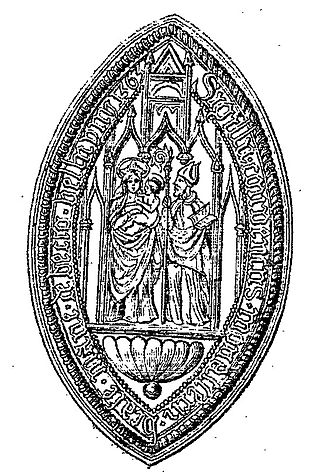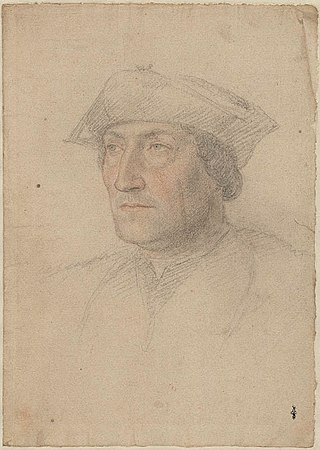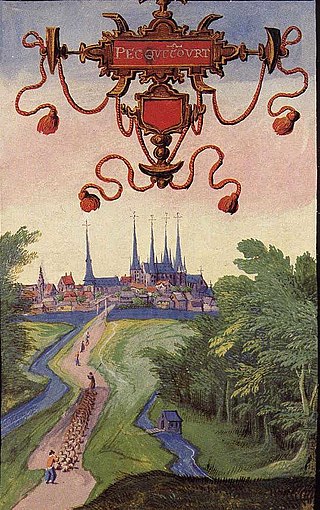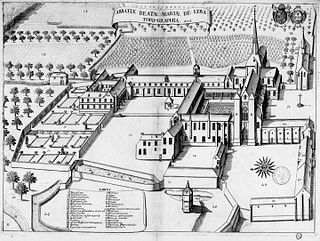
Bec Abbey, formally the Abbey of Our Lady of Bec, is a Benedictine monastic foundation in the Eure département, in the Bec valley midway between the cities of Rouen and Bernay. It is located in Le Bec Hellouin, Normandy, France, and was the most influential abbey of the 12th-century Anglo-Norman kingdom.

Louis de Brézé, Seigneur d'Anet and Comte de Maulevrier was a French nobleman, the grandson of King Charles VII of France by his natural daughter with his mistress Agnès Sorel.

Bernay is a commune in the west of the Eure department in Northern France.

Jean Le Veneur, son of a Norman baron, was a French Abbot, Bishop, Courtier, royal official, and Roman Catholic cardinal.

Vézelay is a commune in the department of Yonne in the north-central French region of Bourgogne-Franche-Comté. It is a defensible hill town famous for Vézelay Abbey. The town and its 11th-century Romanesque Basilica of St Magdalene are designated UNESCO World Heritage Sites.

Le Bec-Hellouin is a commune in the department of Eure in the Normandy region in northern France.

Ouche Abbey or the Abbey of Saint-Evroul is a former Benedictine abbey in Normandy, located in the present commune of Saint-Évroult-Notre-Dame-du-Bois, Orne, Normandy. It has been classified as a Monument historique since 1967 and is designated "classé".

Morsan is a commune in the Eure department in Normandy in northern France. The inhabitants are called Morsanais.
Roger de Bailleul was a medieval Benedictine monk, abbot of Bec, and archbishop-elect of Canterbury.

Anchin Abbey was a Benedictine monastery founded in 1079 in the commune of Pecquencourt in what is now the Nord department of France.
Jean de Montagu or Jean de Montaigu, was a royal secretary and pupil to Charles V, and subsequently an administrator and advisor to Charles VI of France, who became a leading figure in France during the early 15th Century.

Goldcliff Priory was a Benedictine monastery in Goldcliff, Newport, South Wales. It was established in 1113 by Robert de Chandos as a subsidiary house of the Abbey of Bec in Normandy. The priory was built on a coastal site, now the land of Hill Farm. In the 1950s, the Monmouthshire writer Hando noted the outlines of buildings visible as grass patterns or crop marks, but by the 1970s the only remaining structural element was part of a cellar in the farm house.

Igny Abbey or Val d'Igny Abbey is a Cistercian abbey located in Arcis-le-Ponsart, Marne, France. It was founded in 1128 for Cistercian monks, dissolved in 1791 during the French Revolution, re-established in 1876 for Trappist monks, destroyed in 1918, reopened in 1929 for Trappist nuns and modernised in 2008–12 to accommodate three or four pre-existing communities.

Cerisy Abbey, otherwise the Abbey of Saint Vigor, located in Cerisy-la-Forêt, Manche, France, was an important Benedictine monastery of Normandy.

Estold or Estout d'Estouteville was successively abbot of Cerisy Abbey, Bec Abbey and Fécamp Abbey in Normandy, France.
Stoke-by-Clare Priory was a Benedictine monastery in Stoke-by-Clare, in Suffolk, an alien priory, dependent on Bec Abbey, in Normandy. Reinstituted in 1124, the Priory was suppressed in 1415.

Lyre Abbey was a monastery in Normandy, founded in 1046 at what is now the village of La Vieille-Lyre. From the mid-12th century it was a Benedictine house. It was abolished at the French Revolution and the abbey buildings mostly destroyed.
Also known as Richard de Bellevue, Richard de Saint-Léger (born in Fécamp, parish of Saint-Léger, and died on April 4, 1236), was a 13th-century French clergyman, abbot of Bec and then bishop of Évreux.

Thomas Frique or Thomas du Bec was the 28th abbot of Le Bec.

Jean de Boucard was a French prelate, who was confessor and chaplain to Louis XI of France.













